
Caspar David Friedrich Painting Reproductions 1 of 5
1774-1840
German Romanticism Painter
The greatest of the German Romantic artists, Caspar David Friedrich devoted his life to landscape painting, creating mysterious and compelling images of remarkable spiritual intensity. A serious, melancholy figure, whose forbidding appearance was softened by a childlike simplicity, he was only truly content when contemplating the rugged landscapes of his Pomeranian homeland or the stunning German countryside.
Friedrich spent most of his life in Dresden, where he supported the German patriotic movement in the Wars of Liberation. He enjoyed moderate success as an artist, attracting the patronage of the Prussian and the Russian royal families, and made a successful marriage in his mid-forties. But after a major stroke in 1835 he was forced virtually to abandon oil painting. He died in 1840, a sad and broken man.
Caspar David Friedrich was born on 5 September 1774 in the small town of Greifswald on the Baltic coast, the son of a candle-maker and soap-boiler. Friedrich's father, Adolf Gottlieb, was a fairly successful businessman, but more importantly he was a devout Protestant. And like many middle-class children in northern Germany at the time, Caspar David and his nine brothers and sisters experienced a strict, and almost spartan upbringing. This way of life had a lasting influence on the artist: years later, visitors would comment on the frugality of his home and studio.
It seems that Friedrich always had a natural tendency towards introspection and melancholia. This was intensified by a tragic series of deaths in his childhood: he lost his mother in 1781, when he was just seven years old, and two sisters - one in 1782 and another in 1791. But the most traumatic event was the death of his brother, who drowned while trying to save Friedrich himself in a skating accident. This seems to have added a sense of guilt to his grief, making the contemplation of death almost a duty for him. As he later put it: To live one day eternally, one must give oneself over to death many times.'
The fact that Friedrich's preoccupation with religion and death led him to devote his life to landscape painting makes him very much a child of his time. Possibly the works of a local poet, L.T. Kosegarten, first turned his thoughts in this particular direction. For Kosegarten, who was an admirer of such English nature poets as Thomas Gray, was a pastor as well as a poet, and found religious inspiration in the contemplation of nature, which he referred to as "Christ's bible".
Caspar David's first art teacher, Johann Gottfried Quistorp, was a friend of Kosegarten. He seems to have nurtured his young pupil's poetic sentiments, but may also have had a more practical purpose in mind when he encouraged Friedrich's specialization in landscape painting. For the vogue for nature poetry had stimulated the public taste for paintings of the countryside - in particular for picturesque views with primeval or medieval associations. And such views were in rich supply for the young painter: indeed, he was surrounded by them in the remote north German province of Pomerania where he lived. There were many signs of pre-historic settlements in the area, particularly the huge dolmens known as 'Giant's Graves' on the island of Rtigen, just off the Baltic coast. The ruined medieval abbey of Eldena a few miles from Greifswald also inspired him.
When he was 20, Friedrich left his home town and travelled to the Danish capital, Copenhagen, to study art. The academy there was the most celebrated in northern Europe, and Friedrich came into contact with the severe Neo-Classical style prevalent at that time. Like all other students, he set about studying the human figure, but was also strongly influenced by the work of one of his teachers, Jens Juel, who often painted local views full of mood and with sentimental associations. Friedrich felt at odds with the strict, academic approach to art which he encountered at Copenhagen, and later wrote: 'All the teaching and instructing kill man's spiritual nature.'
In 1798, after a brief stay in Berlin, Friedrich went to live in Dresden, which was to remain his base for the rest of his life. The Saxon capital was one of the main art centres of Germany, with a fine collection of Old Masters and a flourishing community of artists and intellectuals. He only ever left the city to visit his relatives back in his native Pomerania, and to make journeys in northern and central Germany to gather material for his landscapes.
At first Friedrich's existence was harsh, but although he lived a somewhat secluded life, the letters written during his first years in Dresden indicate that this was a relatively happy time. Until his name became known in the city, he made his living in various ways: he was employed as a drawing master and even resorted to acting as a guide for tourists. Gradually, he built up a reputation for views of the wild areas of his homeland.
The move to Dresden was critical to Friedrich, for he arrived around the time when the city was becoming the centre of an influential group of writers and critics known as the 'Dresden Romantics'. Rejecting the dry rationality of the classical age, they turned instead to an exploration of the exotic, irrational and mystical aspects of experience. One of the major figures of the group, the critic Friedrich Schlegel, was the first to use the word Romantic to describe the dynamic spirituality of the 'modern age'. And though Friedrich had little contact with the leading members of the group, he had friends among their circle, and quickly absorbed their ideas.
Attempted suicide
It was around 1800 that the artist first began to introduce the mystical and dramatic themes expounded by the Dresden Romantics into his pictures. But there may have also been personal reasons behind this change in his art. Around 1803 he went through an acute period of introspection and depression, and is reported to have tried to kill himself by cutting his throat. There is even a tradition that he grew his beard in order to hide the resulting scar. It is certainly true that Friedrich cultivated a monk-like appearance after this date, acquiring a reputation as an isolated eccentric.
Despite this traumatic incident, the period marks the beginning of his success as an artist. Over the next 10 years Friedrich was to become celebrated throughout Germany, and was patronized by such influential leaders as the Prussian Royal Family and the Duke of Weimar.
An important moment came in 1805 when he shared first prize for the sepias (paintings in a monochrome brown wash) that he sent to the annual exhibition in Weimar. The prize was awarded by the Weimar Friends of Art - in effect, the poet Johann Wolfgang von Goethe and his friend the painter Heinrich Meyer. Goethe was the most celebrated poet and leading cultural figure in Germany at that time and had established an annual art competition in Weimar in the hope of raising pictorial standards. Since his own artistic tastes were classical, it was a rare departure to award a prize for landscape paintings.
Friedrich's growing reputation seems to have encouraged him to move from sepia to the more challenging technique of oil painting. The results of this change can be seen most dramatically in his highly controversial picture, The Cross in the Mountains. Completed in 1808, it shows a silhouette of a mountain top with a cross on it. Contemporaries were astounded that the artist had chosen a 'view' to function as an altarpiece, but Friedrich even designed a special frame for it, with religious symbols to emphasize the point.
Although he was harshly criticized for this work, the notoriety it brought him appears to have done Friedrich more good than harm. In 1810, he enhanced his reputation further when he exhibited Abbey in the Oakwoods, and its companion picture Monk by the Sea. The pictures were acquired by the Prussian Crown Prince, and Friedrich was made a member of the Berlin Academy.
Friedrich's success as a strange and extreme artist was closely related to the current vogue for the Romantics. Since 1806 Germany had been overrun by Napoleon, and Romanticism became a cultural rallying point, a patriotic means of emphasizing 'Germanness'. Its pure spirituality, naturalism and vigour were in stark contrast to the 'artificial posturings' of French art, and Friedrich - the wild man from the north - was an appropriate symbol for such a movement.
But the movement that enhanced Friedrich's reputation also helped bring about its decline. At a time when Germany was divided into a number of small states, Friedrich was among those patriots who sought unification of the country, as a means of bringing about a democratic society and ending the archaic rule of kings and dukes. But after the Napoleonic Wars, the traditional rulers were very much back in power, seeking to eradicate such radicalism. Friedrich became an increasingly isolated figure, regarded as out of date both for his ideas and for the eccentricity of his art.
A happy marriage
However, this decline was a slow and gradual one. At first he made a good living from his art, and in 1816 was made a member of the Dresden Academy - a position that carried a small stipend. He felt sure enough of his position to get married in 1818.
Many friends remarked that Friedrich's lifestyle was little altered by the acquisition of a quiet and unassuming partner. He was 44, and his wife Caroline was less than half his age. But there is a new tone of happiness in his letters: 'It is indeed a droll thing having a wife,' he wrote. "There is more eating, more drinking, more sleeping, more laughing, more bantering, more fooling around.' Deeply fond of children, Friedrich welcomed the arrival of his own two daughters and a son. And from this time, too, his art shows a greater interest in domestic scenes and daily events.
Around this time, Friedrich was making new contacts among a younger generation of artists. His most enduring friendship was with the Norwegian artist Joharm Christian Dahl, who arrived in Dresden in 1818. From 1823, Friedrich and Dahl lived in the same house, on the banks of the River Elbe.
For the younger generation, Dahl was the leader, and in 1824 it was Dahl, rather than Friedrich, who was appointed to the teaching post of Professor of Landscape at the Academy. Despite this, they remained friends - though there was a dark period when Friedrich suspected his wife of having an affair with his friend. The suspicions were without foundation, and are probably best explained as a consequence of the growing ill health that he endured in his last years.
In 1825 Friedrich suffered a stroke. This was followed by other attacks, the most severe being that of 1835, which left him greatly incapacitated. Yet this period was one of great artistic achievement. He developed a new sensitivity to colour and many of his most poignant works - including The Large Enclosure and The Stages of Life come from this time.
This was also the period in which he wrote down most of his ideas on art. Though these mainly consisted of attacks upon the empty naturalism and vainglorious classicism of his contemporaries, there are also positive statements of his spiritual approach to art, including his most quoted remark: 'Close your bodily eye, so that you may see your picture first with the spiritual eye. Then bring to the light of day that which you have seen in the darkness so that it may react on others from the outside inwards.'
When Friedrich died in 1840 he was almost a forgotten figure. Not until the end of the 19th century - when symbolism came back into fashion - did his reputation begin to rise once more.
Landscapes of the Spirit
Friedrich transformed the landscape of his native Pomerania into a mystical world, infused with religious feeling. From precise studies of natural objects, he created strange, otherworldly images.
Caspar David Friedrich is the most important German painter of the Romantic era. He lived at a time when landscape painting took on a new significance, to become a means of celebrating the natural world and the divine power that created it. 'The divine is everywhere/ wrote Friedrich, 'even in a grain of sand.' And for him, the mystical experience of nature was such a central concern that he even painted a landscape for an altarpiece.
Art from the inner darkness
Before beginning a picture, Friedrich advised an artist to 'close his bodily eye' and then bring to light what he saw in the inner darkness. Accounts of the artist in his studio suggest that he did, to some extent, put this into practice. He had nothing but the barest essentials around him so that he would not be distracted from his contemplation. His friend Cams records that Friedrich would stand silently before his canvas until the image of a picture stood 'lifelike before his soul'. Then he would sketch it on to the blank canvas in thin outlines and proceed directly to the painting.
The idea that Friedrich worked entirely from the imagination is slightly exaggerated. It is evident that he consistently used sketches he had made for such individual features as rocks and trees in his pictures. However, he does seem to have used the contemplative method to arrive at his compositions. Despite the fact that his drawings have survived in great number, there are virtually no compositional sketches among them.
This reliance on the mental image emphasizes the visionary nature of Friedrich's work. However, he was not unique - the method was standard among painters of 'ideal' landscapes. What was unusual about Friedrich was that he used the process to arrive at images with powerful, almost hypnotic, impact - memorable images that would stick in the mind.
Early in his career he began to use contrast as a feature of his designs. A central image, like a tree, would be silhouetted against an indefinite background. And Friedrich chose evocative subjects: 'moonlight, sunset glow, the ocean, the beach, snowy landscapes, churchyards, bleak moors, forest torrents, rocky valleys and the like.' Contemporaries were struck by the haunting, enigmatic quality of his work and searched his paintings for hidden meanings.
Religious symbols
Friedrich often used his landscapes to convey religious ideas. In his description of the Cross in the Mountains altarpiece, for example, he wrote that the rock was a symbol of unshakeable faith, while the evergreen fir trees symbolized the eternal hope of mankind. But he also recognized that his paintings could be interpreted on another, naturalistic level. Describing one of his landscapes, he wrote: 'On a bare stony seashore there stands, raised on high, a cross - to those who see it as such, a consolation, to those who do not, simply a cross.'
For the detailed forms in his pictures, Friedrich drew freely on the sketches that he made on his many journeys through northern and central Germany. By and large it seems that these studies were made because the objects interested him, rather than because he had a particular composition in mind. For the most part they were of single objects or small groups - overall views are much rarer. Nor was he concerned about the original location of the forms he combined in his paintings. Rocks and fir trees from northern Bohemia would be incorporated with dolmens and oak trees from Pomerania, apparently without any qualms. It seems that his main concern was to achieve the most striking effect.
A problem with people
When it came to putting people in his landscapes, Friedrich was never very happy painting the figures. In his early works, his friend Kersting sometimes drew the figures for him. Later, Friedrich almost invariably chose to show his figures in back view.
Friedrich only began to paint in oils after 10 years of working in water-colour and sepia. From the first he had thought of these media as the means of colouring or tinting drawings, and this habit affected his method of using oils. He painted very thinly, using small brushes. When painting in sepia he had been in the habit of 'stippling' areas -covering them with minute dots, to give a sense of texture and vibrancy. In his early oils he used a similar method to convey the brilliance of sunlight or the shimmer of moonlight.
Over the years Friedrich gradually extended his range of colors and the breadth of his brush strokes. In the 1820s, he came under the influence of his friend J.C. Dahl, the Norwegian painter. Dahl was in the habit of using oil to make direct studies from nature and Friedrich followed suit on a number of occasions. His enchanting picture of his wife looking out of the window of his studio was painted in this manner.
Friedrich appears to have abandoned this practice after 1824, but did not forget the lessons he had learnt. His last oil paintings are executed in a richer, thicker manner, and show an enhanced sense of color. This is particularly true of works like The Large Enclosure and The Stages of Life. In these the purples, yellows and deep blues of the evening sky are conveyed in broad, smooth areas of paint.
Friedrich also continued to paint in water-color and sepia throughout his life, but he tended to use these media more for topographical than for imaginative work. Only after his stroke in 1835 did he return to using sepia predominantly, painting images which are often meditations on death.
Friedrich spent most of his life in Dresden, where he supported the German patriotic movement in the Wars of Liberation. He enjoyed moderate success as an artist, attracting the patronage of the Prussian and the Russian royal families, and made a successful marriage in his mid-forties. But after a major stroke in 1835 he was forced virtually to abandon oil painting. He died in 1840, a sad and broken man.
Caspar David Friedrich was born on 5 September 1774 in the small town of Greifswald on the Baltic coast, the son of a candle-maker and soap-boiler. Friedrich's father, Adolf Gottlieb, was a fairly successful businessman, but more importantly he was a devout Protestant. And like many middle-class children in northern Germany at the time, Caspar David and his nine brothers and sisters experienced a strict, and almost spartan upbringing. This way of life had a lasting influence on the artist: years later, visitors would comment on the frugality of his home and studio.
It seems that Friedrich always had a natural tendency towards introspection and melancholia. This was intensified by a tragic series of deaths in his childhood: he lost his mother in 1781, when he was just seven years old, and two sisters - one in 1782 and another in 1791. But the most traumatic event was the death of his brother, who drowned while trying to save Friedrich himself in a skating accident. This seems to have added a sense of guilt to his grief, making the contemplation of death almost a duty for him. As he later put it: To live one day eternally, one must give oneself over to death many times.'
The fact that Friedrich's preoccupation with religion and death led him to devote his life to landscape painting makes him very much a child of his time. Possibly the works of a local poet, L.T. Kosegarten, first turned his thoughts in this particular direction. For Kosegarten, who was an admirer of such English nature poets as Thomas Gray, was a pastor as well as a poet, and found religious inspiration in the contemplation of nature, which he referred to as "Christ's bible".
Caspar David's first art teacher, Johann Gottfried Quistorp, was a friend of Kosegarten. He seems to have nurtured his young pupil's poetic sentiments, but may also have had a more practical purpose in mind when he encouraged Friedrich's specialization in landscape painting. For the vogue for nature poetry had stimulated the public taste for paintings of the countryside - in particular for picturesque views with primeval or medieval associations. And such views were in rich supply for the young painter: indeed, he was surrounded by them in the remote north German province of Pomerania where he lived. There were many signs of pre-historic settlements in the area, particularly the huge dolmens known as 'Giant's Graves' on the island of Rtigen, just off the Baltic coast. The ruined medieval abbey of Eldena a few miles from Greifswald also inspired him.
When he was 20, Friedrich left his home town and travelled to the Danish capital, Copenhagen, to study art. The academy there was the most celebrated in northern Europe, and Friedrich came into contact with the severe Neo-Classical style prevalent at that time. Like all other students, he set about studying the human figure, but was also strongly influenced by the work of one of his teachers, Jens Juel, who often painted local views full of mood and with sentimental associations. Friedrich felt at odds with the strict, academic approach to art which he encountered at Copenhagen, and later wrote: 'All the teaching and instructing kill man's spiritual nature.'
In 1798, after a brief stay in Berlin, Friedrich went to live in Dresden, which was to remain his base for the rest of his life. The Saxon capital was one of the main art centres of Germany, with a fine collection of Old Masters and a flourishing community of artists and intellectuals. He only ever left the city to visit his relatives back in his native Pomerania, and to make journeys in northern and central Germany to gather material for his landscapes.
At first Friedrich's existence was harsh, but although he lived a somewhat secluded life, the letters written during his first years in Dresden indicate that this was a relatively happy time. Until his name became known in the city, he made his living in various ways: he was employed as a drawing master and even resorted to acting as a guide for tourists. Gradually, he built up a reputation for views of the wild areas of his homeland.
The move to Dresden was critical to Friedrich, for he arrived around the time when the city was becoming the centre of an influential group of writers and critics known as the 'Dresden Romantics'. Rejecting the dry rationality of the classical age, they turned instead to an exploration of the exotic, irrational and mystical aspects of experience. One of the major figures of the group, the critic Friedrich Schlegel, was the first to use the word Romantic to describe the dynamic spirituality of the 'modern age'. And though Friedrich had little contact with the leading members of the group, he had friends among their circle, and quickly absorbed their ideas.
Attempted suicide
It was around 1800 that the artist first began to introduce the mystical and dramatic themes expounded by the Dresden Romantics into his pictures. But there may have also been personal reasons behind this change in his art. Around 1803 he went through an acute period of introspection and depression, and is reported to have tried to kill himself by cutting his throat. There is even a tradition that he grew his beard in order to hide the resulting scar. It is certainly true that Friedrich cultivated a monk-like appearance after this date, acquiring a reputation as an isolated eccentric.
Despite this traumatic incident, the period marks the beginning of his success as an artist. Over the next 10 years Friedrich was to become celebrated throughout Germany, and was patronized by such influential leaders as the Prussian Royal Family and the Duke of Weimar.
An important moment came in 1805 when he shared first prize for the sepias (paintings in a monochrome brown wash) that he sent to the annual exhibition in Weimar. The prize was awarded by the Weimar Friends of Art - in effect, the poet Johann Wolfgang von Goethe and his friend the painter Heinrich Meyer. Goethe was the most celebrated poet and leading cultural figure in Germany at that time and had established an annual art competition in Weimar in the hope of raising pictorial standards. Since his own artistic tastes were classical, it was a rare departure to award a prize for landscape paintings.
Friedrich's growing reputation seems to have encouraged him to move from sepia to the more challenging technique of oil painting. The results of this change can be seen most dramatically in his highly controversial picture, The Cross in the Mountains. Completed in 1808, it shows a silhouette of a mountain top with a cross on it. Contemporaries were astounded that the artist had chosen a 'view' to function as an altarpiece, but Friedrich even designed a special frame for it, with religious symbols to emphasize the point.
Although he was harshly criticized for this work, the notoriety it brought him appears to have done Friedrich more good than harm. In 1810, he enhanced his reputation further when he exhibited Abbey in the Oakwoods, and its companion picture Monk by the Sea. The pictures were acquired by the Prussian Crown Prince, and Friedrich was made a member of the Berlin Academy.
Friedrich's success as a strange and extreme artist was closely related to the current vogue for the Romantics. Since 1806 Germany had been overrun by Napoleon, and Romanticism became a cultural rallying point, a patriotic means of emphasizing 'Germanness'. Its pure spirituality, naturalism and vigour were in stark contrast to the 'artificial posturings' of French art, and Friedrich - the wild man from the north - was an appropriate symbol for such a movement.
But the movement that enhanced Friedrich's reputation also helped bring about its decline. At a time when Germany was divided into a number of small states, Friedrich was among those patriots who sought unification of the country, as a means of bringing about a democratic society and ending the archaic rule of kings and dukes. But after the Napoleonic Wars, the traditional rulers were very much back in power, seeking to eradicate such radicalism. Friedrich became an increasingly isolated figure, regarded as out of date both for his ideas and for the eccentricity of his art.
A happy marriage
However, this decline was a slow and gradual one. At first he made a good living from his art, and in 1816 was made a member of the Dresden Academy - a position that carried a small stipend. He felt sure enough of his position to get married in 1818.
Many friends remarked that Friedrich's lifestyle was little altered by the acquisition of a quiet and unassuming partner. He was 44, and his wife Caroline was less than half his age. But there is a new tone of happiness in his letters: 'It is indeed a droll thing having a wife,' he wrote. "There is more eating, more drinking, more sleeping, more laughing, more bantering, more fooling around.' Deeply fond of children, Friedrich welcomed the arrival of his own two daughters and a son. And from this time, too, his art shows a greater interest in domestic scenes and daily events.
Around this time, Friedrich was making new contacts among a younger generation of artists. His most enduring friendship was with the Norwegian artist Joharm Christian Dahl, who arrived in Dresden in 1818. From 1823, Friedrich and Dahl lived in the same house, on the banks of the River Elbe.
For the younger generation, Dahl was the leader, and in 1824 it was Dahl, rather than Friedrich, who was appointed to the teaching post of Professor of Landscape at the Academy. Despite this, they remained friends - though there was a dark period when Friedrich suspected his wife of having an affair with his friend. The suspicions were without foundation, and are probably best explained as a consequence of the growing ill health that he endured in his last years.
In 1825 Friedrich suffered a stroke. This was followed by other attacks, the most severe being that of 1835, which left him greatly incapacitated. Yet this period was one of great artistic achievement. He developed a new sensitivity to colour and many of his most poignant works - including The Large Enclosure and The Stages of Life come from this time.
This was also the period in which he wrote down most of his ideas on art. Though these mainly consisted of attacks upon the empty naturalism and vainglorious classicism of his contemporaries, there are also positive statements of his spiritual approach to art, including his most quoted remark: 'Close your bodily eye, so that you may see your picture first with the spiritual eye. Then bring to the light of day that which you have seen in the darkness so that it may react on others from the outside inwards.'
When Friedrich died in 1840 he was almost a forgotten figure. Not until the end of the 19th century - when symbolism came back into fashion - did his reputation begin to rise once more.
Landscapes of the Spirit
Friedrich transformed the landscape of his native Pomerania into a mystical world, infused with religious feeling. From precise studies of natural objects, he created strange, otherworldly images.
Caspar David Friedrich is the most important German painter of the Romantic era. He lived at a time when landscape painting took on a new significance, to become a means of celebrating the natural world and the divine power that created it. 'The divine is everywhere/ wrote Friedrich, 'even in a grain of sand.' And for him, the mystical experience of nature was such a central concern that he even painted a landscape for an altarpiece.
Art from the inner darkness
Before beginning a picture, Friedrich advised an artist to 'close his bodily eye' and then bring to light what he saw in the inner darkness. Accounts of the artist in his studio suggest that he did, to some extent, put this into practice. He had nothing but the barest essentials around him so that he would not be distracted from his contemplation. His friend Cams records that Friedrich would stand silently before his canvas until the image of a picture stood 'lifelike before his soul'. Then he would sketch it on to the blank canvas in thin outlines and proceed directly to the painting.
The idea that Friedrich worked entirely from the imagination is slightly exaggerated. It is evident that he consistently used sketches he had made for such individual features as rocks and trees in his pictures. However, he does seem to have used the contemplative method to arrive at his compositions. Despite the fact that his drawings have survived in great number, there are virtually no compositional sketches among them.
This reliance on the mental image emphasizes the visionary nature of Friedrich's work. However, he was not unique - the method was standard among painters of 'ideal' landscapes. What was unusual about Friedrich was that he used the process to arrive at images with powerful, almost hypnotic, impact - memorable images that would stick in the mind.
Early in his career he began to use contrast as a feature of his designs. A central image, like a tree, would be silhouetted against an indefinite background. And Friedrich chose evocative subjects: 'moonlight, sunset glow, the ocean, the beach, snowy landscapes, churchyards, bleak moors, forest torrents, rocky valleys and the like.' Contemporaries were struck by the haunting, enigmatic quality of his work and searched his paintings for hidden meanings.
Religious symbols
Friedrich often used his landscapes to convey religious ideas. In his description of the Cross in the Mountains altarpiece, for example, he wrote that the rock was a symbol of unshakeable faith, while the evergreen fir trees symbolized the eternal hope of mankind. But he also recognized that his paintings could be interpreted on another, naturalistic level. Describing one of his landscapes, he wrote: 'On a bare stony seashore there stands, raised on high, a cross - to those who see it as such, a consolation, to those who do not, simply a cross.'
For the detailed forms in his pictures, Friedrich drew freely on the sketches that he made on his many journeys through northern and central Germany. By and large it seems that these studies were made because the objects interested him, rather than because he had a particular composition in mind. For the most part they were of single objects or small groups - overall views are much rarer. Nor was he concerned about the original location of the forms he combined in his paintings. Rocks and fir trees from northern Bohemia would be incorporated with dolmens and oak trees from Pomerania, apparently without any qualms. It seems that his main concern was to achieve the most striking effect.
A problem with people
When it came to putting people in his landscapes, Friedrich was never very happy painting the figures. In his early works, his friend Kersting sometimes drew the figures for him. Later, Friedrich almost invariably chose to show his figures in back view.
Friedrich only began to paint in oils after 10 years of working in water-colour and sepia. From the first he had thought of these media as the means of colouring or tinting drawings, and this habit affected his method of using oils. He painted very thinly, using small brushes. When painting in sepia he had been in the habit of 'stippling' areas -covering them with minute dots, to give a sense of texture and vibrancy. In his early oils he used a similar method to convey the brilliance of sunlight or the shimmer of moonlight.
Over the years Friedrich gradually extended his range of colors and the breadth of his brush strokes. In the 1820s, he came under the influence of his friend J.C. Dahl, the Norwegian painter. Dahl was in the habit of using oil to make direct studies from nature and Friedrich followed suit on a number of occasions. His enchanting picture of his wife looking out of the window of his studio was painted in this manner.
Friedrich appears to have abandoned this practice after 1824, but did not forget the lessons he had learnt. His last oil paintings are executed in a richer, thicker manner, and show an enhanced sense of color. This is particularly true of works like The Large Enclosure and The Stages of Life. In these the purples, yellows and deep blues of the evening sky are conveyed in broad, smooth areas of paint.
Friedrich also continued to paint in water-color and sepia throughout his life, but he tended to use these media more for topographical than for imaginative work. Only after his stroke in 1835 did he return to using sepia predominantly, painting images which are often meditations on death.
105 Caspar David Friedrich Paintings
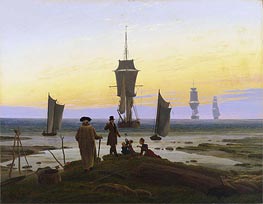
The Stages of Life (Lebensstufen) c.1835
Oil Painting
$1443
$1443
Canvas Print
$60.00
$60.00
SKU: FCD-2904
Caspar David Friedrich
Original Size: 72.5 x 94 cm
Museum der Bildenden Kunste, Leipzig, Germany
Caspar David Friedrich
Original Size: 72.5 x 94 cm
Museum der Bildenden Kunste, Leipzig, Germany

Oak Tree in Snow c.1829
Oil Painting
$1087
$1087
Canvas Print
$53.86
$53.86
SKU: FCD-2907
Caspar David Friedrich
Original Size: 71 x 48 cm
Gemaldegalerie, Berlin, Germany
Caspar David Friedrich
Original Size: 71 x 48 cm
Gemaldegalerie, Berlin, Germany
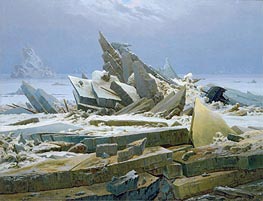
The Polar Sea (The Sea of Ice) c.1823/24
Oil Painting
$1278
$1278
Canvas Print
$58.47
$58.47
SKU: FCD-2908
Caspar David Friedrich
Original Size: 96.7 x 126.9 cm
Hamburger Kunsthalle, Hamburg, Germany
Caspar David Friedrich
Original Size: 96.7 x 126.9 cm
Hamburger Kunsthalle, Hamburg, Germany
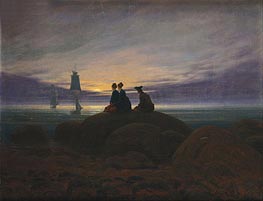
The Moon Rising over the Sea c.1822
Oil Painting
$959
$959
Canvas Print
$58.89
$58.89
SKU: FCD-2909
Caspar David Friedrich
Original Size: 55 x 71 cm
Gemaldegalerie, Berlin, Germany
Caspar David Friedrich
Original Size: 55 x 71 cm
Gemaldegalerie, Berlin, Germany
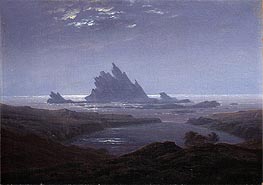
Rocky Reef on the Sea Shore c.1824
Oil Painting
$525
$525
Canvas Print
$50.63
$50.63
SKU: FCD-2910
Caspar David Friedrich
Original Size: 22 x 31 cm
Staatliche Kunsthalle, Karlsruhe, Germany
Caspar David Friedrich
Original Size: 22 x 31 cm
Staatliche Kunsthalle, Karlsruhe, Germany
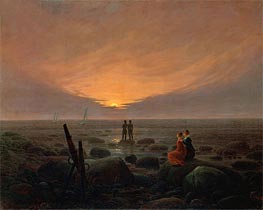
Moonrise over the Sea 1821
Oil Painting
$1226
$1226
Canvas Print
$60.84
$60.84
SKU: FCD-2911
Caspar David Friedrich
Original Size: 135 x 170 cm
The State Hermitage Museum, St. Petersburg, Russia
Caspar David Friedrich
Original Size: 135 x 170 cm
The State Hermitage Museum, St. Petersburg, Russia
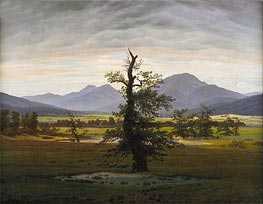
Village Landscape in Morning Light (The Lone Tree) 1822
Oil Painting
$1306
$1306
Canvas Print
$60.28
$60.28
SKU: FCD-2912
Caspar David Friedrich
Original Size: 55 x 71 cm
Gemaldegalerie, Berlin, Germany
Caspar David Friedrich
Original Size: 55 x 71 cm
Gemaldegalerie, Berlin, Germany
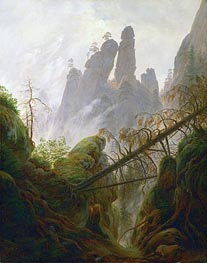
Rocky Ravine c.1822/23
Oil Painting
$1482
$1482
Canvas Print
$60.28
$60.28
SKU: FCD-2913
Caspar David Friedrich
Original Size: 94 x 74 cm
Kunsthistorisches Museum, Vienna, Austria
Caspar David Friedrich
Original Size: 94 x 74 cm
Kunsthistorisches Museum, Vienna, Austria
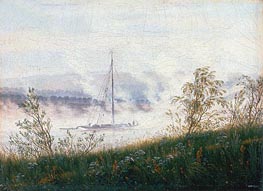
Boat on the River Elbe in the Early Morning Mist c.1820
Oil Painting
$565
$565
Canvas Print
$50.63
$50.63
SKU: FCD-2914
Caspar David Friedrich
Original Size: 22.5 x 30.8 cm
Wallraf-Richartz-Museum, Cologne, Germany
Caspar David Friedrich
Original Size: 22.5 x 30.8 cm
Wallraf-Richartz-Museum, Cologne, Germany
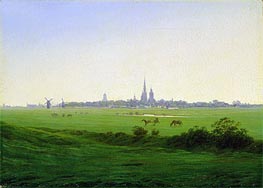
Meadows near Greifswald c.1822
Oil Painting
$721
$721
Canvas Print
$50.63
$50.63
SKU: FCD-2915
Caspar David Friedrich
Original Size: 34.5 x 48.3 cm
Hamburger Kunsthalle, Hamburg, Germany
Caspar David Friedrich
Original Size: 34.5 x 48.3 cm
Hamburger Kunsthalle, Hamburg, Germany
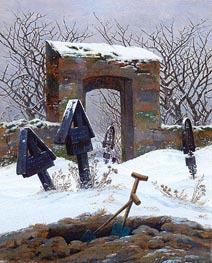
Graveyard under Snow c.1826/27
Oil Painting
$580
$580
Canvas Print
$50.63
$50.63
SKU: FCD-2916
Caspar David Friedrich
Original Size: 31 x 25.3 cm
Museum der Bildenden Kunste, Leipzig, Germany
Caspar David Friedrich
Original Size: 31 x 25.3 cm
Museum der Bildenden Kunste, Leipzig, Germany
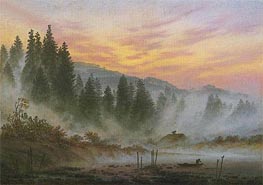
Morning 1821
Oil Painting
$663
$663
Canvas Print
$50.63
$50.63
SKU: FCD-2917
Caspar David Friedrich
Original Size: 22 x 30.7 cm
Niedersachsisches Landesmuseum, Hanover, Germany
Caspar David Friedrich
Original Size: 22 x 30.7 cm
Niedersachsisches Landesmuseum, Hanover, Germany
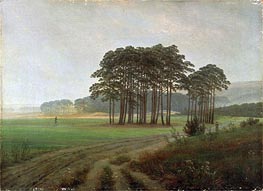
The Noon c.1820/25
Oil Painting
$663
$663
Canvas Print
$50.63
$50.63
SKU: FCD-2918
Caspar David Friedrich
Original Size: 21.5 x 30.4 cm
Niedersachsisches Landesmuseum, Hanover, Germany
Caspar David Friedrich
Original Size: 21.5 x 30.4 cm
Niedersachsisches Landesmuseum, Hanover, Germany
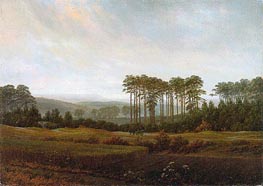
Afternoon 1822
Oil Painting
$663
$663
Canvas Print
$50.63
$50.63
SKU: FCD-2919
Caspar David Friedrich
Original Size: 22 x 30.7 cm
Niedersachsisches Landesmuseum, Hanover, Germany
Caspar David Friedrich
Original Size: 22 x 30.7 cm
Niedersachsisches Landesmuseum, Hanover, Germany

Evening c.1820/26
Oil Painting
$686
$686
Canvas Print
$50.63
$50.63
SKU: FCD-2920
Caspar David Friedrich
Original Size: 22 x 31 cm
Niedersachsisches Landesmuseum, Hanover, Germany
Caspar David Friedrich
Original Size: 22 x 31 cm
Niedersachsisches Landesmuseum, Hanover, Germany
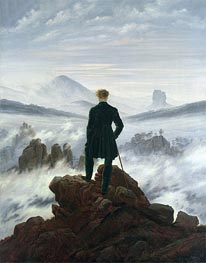
The Wanderer Above a Sea of Mist 1818
Oil Painting
$854
$854
Canvas Print
$60.14
$60.14
SKU: FCD-2921
Caspar David Friedrich
Original Size: 98.4 x 74.8 cm
Hamburger Kunsthalle, Hamburg, Germany
Caspar David Friedrich
Original Size: 98.4 x 74.8 cm
Hamburger Kunsthalle, Hamburg, Germany
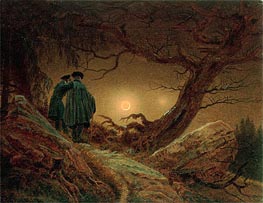
Two Men Contemplating the Moon c.1819/20
Oil Painting
$841
$841
Canvas Print
$50.63
$50.63
SKU: FCD-2922
Caspar David Friedrich
Original Size: 33 x 44.5 cm
Gemaldegalerie Alte Meister, Dresden, Germany
Caspar David Friedrich
Original Size: 33 x 44.5 cm
Gemaldegalerie Alte Meister, Dresden, Germany
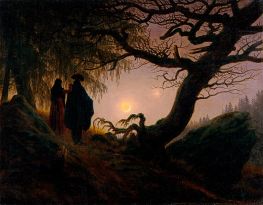
Man and Woman Contemplating the Moon c.1824
Oil Painting
$734
$734
Canvas Print
$50.63
$50.63
SKU: FCD-2923
Caspar David Friedrich
Original Size: 34 x 44 cm
Gemaldegalerie, Berlin, Germany
Caspar David Friedrich
Original Size: 34 x 44 cm
Gemaldegalerie, Berlin, Germany
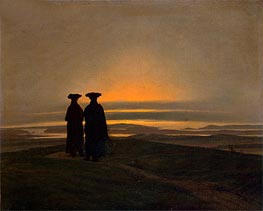
Sunset, Brothers (Evening Landscape with Two Men) c.1830/35
Oil Painting
$614
$614
Canvas Print
$50.63
$50.63
SKU: FCD-2924
Caspar David Friedrich
Original Size: 26 x 31 cm
The State Hermitage Museum, St. Petersburg, Russia
Caspar David Friedrich
Original Size: 26 x 31 cm
The State Hermitage Museum, St. Petersburg, Russia

The Tree of Crows c.1822
Oil Painting
$1482
$1482
Canvas Print
$60.84
$60.84
SKU: FCD-2925
Caspar David Friedrich
Original Size: 59 x 73.7 cm
Louvre Museum, Paris, France
Caspar David Friedrich
Original Size: 59 x 73.7 cm
Louvre Museum, Paris, France
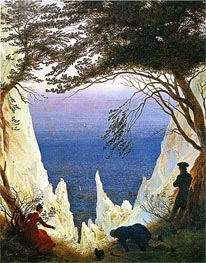
Chalk Cliffs on Rugen 1818
Oil Painting
$1427
$1427
Canvas Print
$59.58
$59.58
SKU: FCD-2926
Caspar David Friedrich
Original Size: 90.5 x 71 cm
Oskar Reinhart Museum, Winterthur, Switzerland
Caspar David Friedrich
Original Size: 90.5 x 71 cm
Oskar Reinhart Museum, Winterthur, Switzerland

On the Sailing Boat c.1818/20
Oil Painting
$1242
$1242
Canvas Print
$59.45
$59.45
SKU: FCD-2927
Caspar David Friedrich
Original Size: 71 x 56 cm
The State Hermitage Museum, St. Petersburg, Russia
Caspar David Friedrich
Original Size: 71 x 56 cm
The State Hermitage Museum, St. Petersburg, Russia
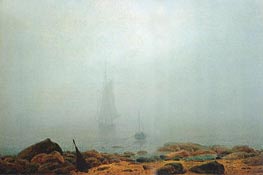
Mist 1807
Oil Painting
$634
$634
Canvas Print
$50.63
$50.63
SKU: FCD-2928
Caspar David Friedrich
Original Size: 34.5 x 52 cm
Galerie Belvedere, Vienna, Austria
Caspar David Friedrich
Original Size: 34.5 x 52 cm
Galerie Belvedere, Vienna, Austria
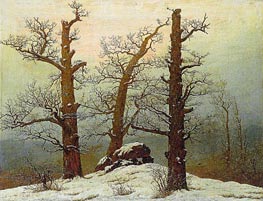
Dolmen in the Snow 1807
Oil Painting
$1295
$1295
Canvas Print
$58.60
$58.60
SKU: FCD-2929
Caspar David Friedrich
Original Size: 61 x 80 cm
Galerie Neue Meister, Dresden, Germany
Caspar David Friedrich
Original Size: 61 x 80 cm
Galerie Neue Meister, Dresden, Germany